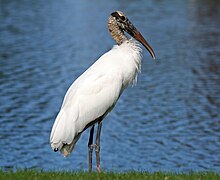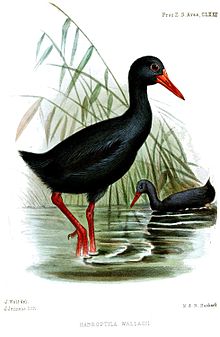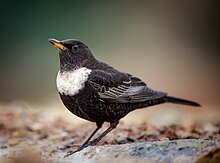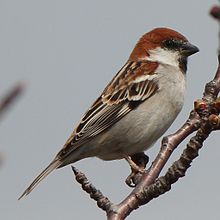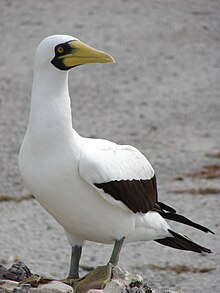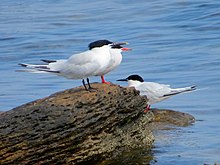Our website is made possible by displaying online advertisements to our visitors.
Please consider supporting us by disabling your ad blocker.
Portal:Birds
The Birds Portal

Birds are a group of warm-blooded vertebrates constituting the class Aves (Latin: [ˈaveːs]), characterised by feathers, toothless beaked jaws, the laying of hard-shelled eggs, a high metabolic rate, a four-chambered heart, and a strong yet lightweight skeleton. Birds live worldwide and range in size from the 5.5 cm (2.2 in) bee hummingbird to the 2.8 m (9 ft 2 in) common ostrich. There are over 11,000 living species and they are split into 44 orders. More than half are passerine or "perching" birds. Birds have wings whose development varies according to species; the only known groups without wings are the extinct moa and elephant birds. Wings, which are modified forelimbs, gave birds the ability to fly, although further evolution has led to the loss of flight in some birds, including ratites, penguins, and diverse endemic island species. The digestive and respiratory systems of birds are also uniquely adapted for flight. Some bird species of aquatic environments, particularly seabirds and some waterbirds, have further evolved for swimming. The study of birds is called ornithology.
Birds are feathered theropod dinosaurs and constitute the only known living dinosaurs. Likewise, birds are considered reptiles in the modern cladistic sense of the term, and their closest living relatives are the crocodilians. Birds are descendants of the primitive avialans (whose members include Archaeopteryx) which first appeared during the Late Jurassic. According to some estimates, modern birds (Neornithes) evolved in the Late Cretaceous or between the Early and Late Cretaceous (100 Ma) and diversified dramatically around the time of the Cretaceous–Paleogene extinction event 66 million years ago, which killed off the pterosaurs and all non-ornithuran dinosaurs.
Many social species preserve knowledge across generations (culture). Birds are social, communicating with visual signals, calls, and songs, and participating in such behaviour as cooperative breeding and hunting, flocking, and mobbing of predators. The vast majority of bird species are socially (but not necessarily sexually) monogamous, usually for one breeding season at a time, sometimes for years, and rarely for life. Other species have breeding systems that are polygynous (one male with many females) or, rarely, polyandrous (one female with many males). Birds produce offspring by laying eggs which are fertilised through sexual reproduction. They are usually laid in a nest and incubated by the parents. Most birds have an extended period of parental care after hatching.
Many species of birds are economically important as food for human consumption and raw material in manufacturing, with domesticated and undomesticated birds being important sources of eggs, meat, and feathers. Songbirds, parrots, and other species are popular as pets. Guano (bird excrement) is harvested for use as a fertiliser. Birds figure throughout human culture. About 120 to 130 species have become extinct due to human activity since the 17th century, and hundreds more before then. Human activity threatens about 1,200 bird species with extinction, though efforts are underway to protect them. Recreational birdwatching is an important part of the ecotourism industry. (Full article...)
Featured articles
Selected general bird topic

Preening is a maintenance behaviour found in birds that involves the use of the beak to position feathers, interlock feather barbules that have become separated, clean plumage, and keep ectoparasites in check. Feathers contribute significantly to a bird's insulation, waterproofing and aerodynamic flight, and so are vital to its survival. Because of this, birds spend considerable time each day maintaining their feathers, primarily through preening. Several actions make up preening behaviour. Birds fluff up and shake their feathers, which helps to "rezip" feather barbules that have become unhooked. Using their beaks, they gather preen oil from a gland at the base of their tail and distribute this oil through their feathers. They draw each contour feather through their bill, nibbling it from base to tip.
Over time, some elements of preening have evolved to have secondary functions. Ritualised preening has become a part of some courtship displays, for example. It is also a displacement activity that can occur when birds are subjected to two conflicting drives. Though primarily an individual function, preening can be a social activity involving two or more birds – a behaviour known as allopreening. In general, allopreening occurs either between two members of a mated pair or between flock members in a social species. Such behaviour may assist in effective grooming, in the recognition of individuals (mates or potential sexual partners), or in reducing or redirecting potential aggressive tendencies in social species. Most allopreening is confined to the head and neck, smaller efforts being directed towards other parts of the body. (Full article...)
Selected taxon
Terns are seabirds in the family Laridae, subfamily Sterninae, that have a worldwide distribution and are normally found near the sea, rivers, or wetlands. Terns are treated in eleven genera in a subgroup of the family Laridae, which also includes several genera of gulls and the skimmers (Rynchops). They are slender, lightly built birds with long, forked tails, narrow wings, long bills, and relatively short legs. Most species are pale grey above and white below with a contrasting black cap to the head, but the marsh terns, the black-bellied tern, the Inca tern, and some noddies have dark body plumage for at least part of the year. The sexes are identical in appearance, but young birds are readily distinguishable from adults. Terns have a non-breeding plumage, which usually involves a white forehead and much-reduced black cap.
Terns are long-lived birds and are relatively free from natural predators and parasites; most species are declining in numbers due directly or indirectly to human activities, including habitat loss, pollution, disturbance, and predation by introduced mammals. The Chinese crested tern is critically endangered and three other species are classed as endangered. International agreements provide a measure of protection, but adults and eggs of some species are still used for food in the tropics. (Full article...)
Topics
Anatomy: Anatomy • Skeleton • Flight • Eggs • Feathers • Plumage
Evolution and extinction: Evolution • Archaeopteryx • Hybridisation • Late Quaternary prehistoric birds • Fossils • Taxonomy • Extinction
Behaviour: Singing • Intelligence • Migration • Reproduction • Nesting • Incubation • Brood parasites
Bird orders: Struthioniformes • Tinamiformes • Anseriformes • Accipitriformes • Galliformes • Gaviiformes • Podicipediformes • Procellariiformes • Sphenisciformes • Pelecaniformes • Ciconiiformes • Phoenicopteriformes • Falconiformes • Gruiformes • Charadriiformes • Pteroclidiformes • Columbiformes • Psittaciformes • Cuculiformes • Strigiformes • Caprimulgiformes • Apodiformes • Coraciiformes • Piciformes • Trogoniformes • Coliiformes • Passeriformes
Bird lists: Families and orders • Lists by region
Birds and humans: Ringing • Ornithology • Bird collections • Birdwatching • Birdfeeding • Conservation • Aviculture
Quotes
| “ | If it looks like a duck, and quacks like a duck, we have at least to consider the possibility that we have a small aquatic bird of the family Anatidae on our hands. | ” |
Resources
Free online resources:
- SORA: The Searchable Online Research Archive (SORA) has decades worth of archives of the following journals: The Auk, The Condor, Journal of Field Ornithology, North American Bird Bander, Studies in Avian Biology, Pacific Coast Avifauna, and The Wilson Bulletin. Coverage ends around 2000. The ability to search all journals or browse exists on the front page.
- Notornis: The Journal of the Ornithological Society of New Zealand covers New Zealand and the South Pacific.
- New Zealand Journal of Ecology: This journal often publishes bird-related articles. Like Notornis, this journal is concerned with New Zealand and surrounding areas.
- Marine Ornithology: Published by the numerous seabird research groups, Marine Ornithology is specific and goes back many years.
- BirdLife International: The Data Zone has species accounts for every species, although threatened species and some key groups have greater detail with others only having status and evaluation.
- Author Index: This is a good source for binomial authorities for taxoboxes.
There is also Birds of North America, Cornell University's massive project collecting information on every breeding bird in the ABA area. It is available for US$40 a year.
For more sources, including printed sources, see WikiProject Birds.
WikiProjects
Selected images
Selected bird anatomy topic

The tactile corpuscles of Grandry or Grandry corpuscles are mechanoreceptors found in the beak skin and oral mucosa of aquatic birds including waterfowl. They were first described in 1869 in the bill skin of ducks and geese. Their general structure includes the flattened endings of an afferent nerve fiber sandwiched between two or more somewhat flattened sensory cells called Grandry cells, all surrounded by a layer of satellite cells and a partial capsule of collagen protein. Electrophysiological studies have shown that Grandry corpuscles function as rapidly adapting velocity detectors. In birds, Grandry and Merkel corpuscles share many morphological similarities, which has led to some confusion in the literature over their classification (see §Grandry and Merkel corpuscles). (Full article...)
Selected species
Did you know
- ...that the rufous hornero, a common species in the ovenbird family, is the national bird of Argentina?
- ...that the eastern whipbird (pictured) of the Australian wet forests is so named for its loud call which resembles the cracking of a whip?
- ...that the rusty-barred owl is one of the only two members of the Strix genus of birds to be found in South America?
Categories
Related portals
Things you can do
Create requested articles (WikiProject Birds – Article requests):
Do these tasks:
 |
Here are some tasks awaiting attention:
|
More outstanding tasks at the project's cleanup listing, Category:Birds articles needing attention, and Wikipedia:WikiProject Birds/Todo.
Taxonomy of Aves
| Class Aves, divided into superorders, orders, suborders (where indicated), and families. | ||||
|---|---|---|---|---|
|
Associated Wikimedia
The following Wikimedia Foundation sister projects provide more on this subject:
-
Commons
Free media repository -
Wikibooks
Free textbooks and manuals -
Wikidata
Free knowledge base -
Wikinews
Free-content news -
Wikiquote
Collection of quotations -
Wikisource
Free-content library -
Wikispecies
Directory of species -
Wikiversity
Free learning tools -
Wikivoyage
Free travel guide -
Wiktionary
Dictionary and thesaurus
Sources
- ^ Adams, Douglas (1987). Dirk Gently's Holistic Detective Agency. New York, NY, US: Pocket Books. p. 270. ISBN 978-0-671-74672-8.
Previous Page Next Page




